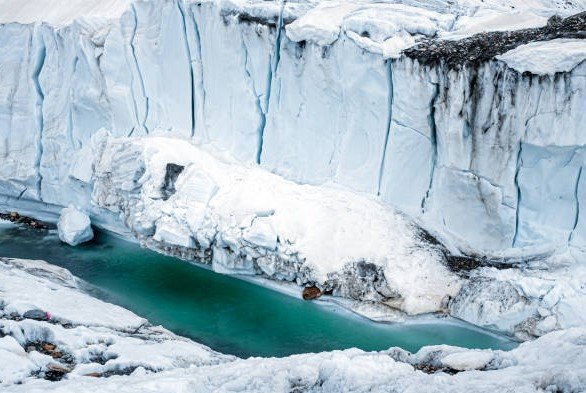A new study reveals that retreating glaciers release fewer vital nutrients into waterways, which could harm marine ecosystems. In India’s Himalayan region, similar melting patterns raise alarms for river flows and coastal food systems that support millions.
Scientists at a leading oceanography institute examined two Alaskan glaciers to understand how retreat affects nutrient levels in meltwater. Their findings show that faster-melting ice leads to lower amounts of iron and manganese reaching the sea. These elements feed plankton at the base of ocean food chains. The research points to broader risks as global warming speeds up glacier loss worldwide.
This issue hits close to home in India, where Himalayan glaciers feed major rivers like the Ganges and Indus. As these ice masses shrink, they form new lakes and alter water supplies. Experts warn that nutrient-poor runoff could ripple into marine areas, affecting fish stocks and livelihoods along the coasts.

Alaskan Study Reveals Nutrient Decline
The study focused on glaciers in Alaska’s Kenai Peninsula. One glacier remained stable, while the other retreated about 15 kilometers since 1950. Researchers collected ice and sediment samples in a controlled setting to measure nutrient content.
They found big differences in bioavailable iron and manganese. The stable glacier provided higher levels of these nutrients in its meltwater. In contrast, the retreating glacier’s output dropped sharply due to longer exposure to water before reaching the ocean.
Chemical changes during this process reduce nutrient quality. Plankton rely on these elements to grow, and without them, entire food webs suffer. Fish populations decline, hitting fisheries that people depend on for food and income.
This year, similar patterns emerged in reports from other cold regions. Glaciers in Greenland and Antarctica show comparable nutrient shifts, linking back to rising temperatures.
Himalayan Glaciers Face Rapid Retreat
In India, Himalayan glaciers melt at alarming rates, according to recent satellite data. Over the past few decades, many have lost significant mass, with some retreating meters each year.
A 2025 analysis shows glaciers in regions like Ladakh and Kashmir shrinking faster than expected. For example, the Kolahoi Glacier in Kashmir has reduced by 23 percent since 1962. Warmer air thins the ice, creating more glacial lakes that pose flood risks.
These changes disrupt river systems. The Ganges, Brahmaputra, and Indus rely on meltwater for steady flow. Initial melting boosts water volume, but long-term loss leads to shortages during dry seasons.
Communities in northern India feel the impact. Farmers face uncertain irrigation, and cities struggle with drinking water. A report this year predicts up to 75 percent of Himalayan ice could vanish by 2100 if emissions continue unchecked.
- Key rivers affected: Ganges, Indus, Brahmaputra.
- Population at risk: Over one billion people in South Asia.
- Recent event: In 2025, a glacial lake outburst flood hit parts of Uttarakhand, highlighting dangers.
Nutrient Loss and Marine Impacts
Drawing from the Alaskan findings, Himalayan meltwater may carry fewer nutrients downstream. Iron and manganese from glacial sediments nourish river and ocean life. But retreat allows more weathering, stripping these elements.
Rivers carry this altered water to the Bay of Bengal and Arabian Sea. Plankton blooms there support fish like sardines and tuna, vital for India’s fishing industry.
If nutrient levels drop, marine food chains weaken. Fish catches could fall, affecting millions of coastal workers. A 2025 study on similar ecosystems in Alaska noted a 20 percent decline in plankton where nutrients decreased.
India’s coasts already face overfishing and pollution. Adding nutrient loss from upstream glaciers compounds the problem. Logical reasoning suggests that without action, seafood supplies dwindle, raising food prices and hunger risks.
| Nutrient | Stable Glacier Level | Retreating Glacier Level | Potential Impact on Marine Life |
|---|---|---|---|
| Iron | 18 percent bioavailable | 13 percent bioavailable | Reduced plankton growth, fewer fish |
| Manganese | 26 percent bioavailable | 14-15 percent bioavailable | Weaker food chains, economic losses for fisheries |
Water Supply Threats in India
Glacier melt reshapes India’s water landscape. New lakes form as ice recedes, but they bring hazards like sudden floods. In 2025, monitoring programs tracked over 1,200 glaciers showing annual mass loss.
Downstream, this means less reliable water for agriculture. Rice and wheat fields in the Indo-Gangetic plain depend on these rivers. Shortages could cut crop yields by 10 to 20 percent in coming decades.
Urban areas like Delhi and Kolkata also rely on Himalayan sources. Power generation from hydropower dams suffers when flows become unpredictable.
Experts link these changes to climate shifts. Rising temperatures, up two degrees Celsius in parts of the Himalayas since 2000, drive the melt. Recent events, such as heatwaves in 2025, accelerate the process.
Future Risks and Global Connections
Looking ahead, projections paint a grim picture. By 2050, river flows might drop 30 percent in dry months, per climate models. This ties into global patterns, where polar and mountain ice loss affects sea levels and weather.
In India, coastal regions brace for combined threats: nutrient-poor waters and rising seas. Mangrove ecosystems, which protect shores and nurture fish, could suffer.
International efforts highlight the issue. Discussions at 2025 climate summits focused on glacier preservation. Yet, without emission cuts, the Third Pole continues to thaw.
Steps to Mitigate the Crisis
Governments and communities take action. India invests in glacier monitoring with satellites and ground stations. Early warning systems for floods save lives.
Conservation groups push for reforestation to cool local climates. Reducing fossil fuel use globally remains key to slowing melt.
Individuals help by cutting energy waste and supporting green policies. These steps build resilience against water and food shortages.
Share this article if it raised your awareness about glacier melt and its far-reaching effects. Comment below with your thoughts on how we can protect our rivers and oceans.
